2017 Harley-Davidson Street Rod First Ride Review
Harley lets fly an angrier, urban-sport version of its lovable Street 750
As a lifelong rooter for the underdog, I really wanted to like this one. Almost three years ago, I was a big fan of the original Street 750, which wasn’t so easy because it did have a couple of glaring shortcomings. But it was such a friendly little approachable motorcycle I liked it anyway – then H-D gave it a better front brake and cured its main malfunction. But the critics still panned its lack of cornering clearance, its mundane parts manifest and its frankly sloppy fit and finish. All legit complaints, but I always liked the little Harley’s potential. The cut of its jib.
2017 Harley-Davidson Street Rod
| Engine | 16.0/20 |
| Suspension/Handling | 12.0/15 |
| Transmission/Clutch | 7.5/10 |
| Brakes | 8.0/10 |
| Instruments/Controls | 3.5/5 |
| Ergonomics/Comfort | 4.0/10 |
| Appearance/Quality | 8.0/10 |
| Desirability | 8.0/10 |
| Value | 7.0/10 |
| Overall Score | 74/100 |
So when Harley let fly the press release and photos of the new Street Rod a couple weeks ago, I felt personally vindicated, like watching your spaghetti-armed kid suddenly pound one over the centerfield fence. Yess! Four-point-six inches of rear suspension travel?! Inverted fork, 17-inch rubber, 18% more power, excellent cornering clearance? It had seemed like none of these are in the Motor Company’s playbook. But now it all appears to be an old-school medium-displacement standard sporty motorcycle, one like the recent Triumph Street Twin, upon which you can motor comfortably around on all day every day, but with H-D’s dark custom murdered-out-in-America swagger, a bike you can wear skulls on and pack heat. Home run!
Fast forward to Daytona Beach and yours truly climbing aboard for the maiden voyage. It’s a bit difficult to put my right foot down out there pretty far abeam of the exhaust collector, but not too big a deal (don’t think you’ll want to wear your capri pants on this one). And there’s a little jockeying for position between your left foot and its peg, too. Did I say jockey? I sort of felt like one as I pulled my legs way up onto the pegs to motor off for the first time. I got those little hip cramps in both of mine. But I imagine it’s a thing I’ll adjust to and be fine. At least they’re stylish footpegs – Brian Dondlinger the lead engineer says they’re H-D’s first aluminum ones.
To get that increased cornering clearance, the pegs had to come up, which they did, and also back a few inches. But the right one also had to move outward a bit (because using a new exhaust system was forbidden), and then so did the left peg in order to keep things symmetrical. The seat was raised, too, but also moved forward a bit on a revised frame, along with the fuel tank – all to shift a bit more weight onto the front contact patch. Then Styling went back and forth with Engineering (and who knows who else), and decided to use a flat, drag-style handlebar instead of the pullback one from the original Street.
At the end of the day, it’s not a bad position for tooling along at a nice 65 mph or so in the Florida outback or riding Seabiscuit down the stretch, but it’s a pretty uncomfortable one for being stuck on in Bike Week traffic. Because every time you stop, you have to either stick your right foot pretty far out past the exhaust and right peg, or just leave it in first gear, hold in the clutch, and keep the right foot on the peg. Careful with the left leg, though; the back of your thigh is now in close proximity to the rear cylinder head since they narrowed the seat up there. At least the clutch is pretty light, but it’s also grabby/juddery in a way the Street 750 only hinted at occasionally: That could be because overall gearing is taller due to the greater circumference of the new 17-inch rear tire.
From behind, tall guys riding the Street Rod look like they’re sitting on milking stools reaching up under a cow. Honestly I think I could be less critical of the cramped legroom if they’d left the pullback handlebar in place. You have to bend a bit to grab the flat one that won out in committee. What worked best for me at 80 mph and 5000 rpm on a chilly Florida morning wound up being prone on the tank, feet on passenger pegs. I hate to be a jerk, but hasn’t anybody at Harley ridden a Triumph Street Twin or a Honda CB500F? Being able to go around corners and being comfortable are not mutually exclusive goals.
Then again, I could just be getting crotchety. The kids this bike wants to attract put up with some pretty ridiculous things for the sake of fashion. Sunglasses inside the faceport of old-school full-face helmets without a shield on a 45-degree morning. Old-school full-face helmets with shields that don’t open at all. I saw more than one of their pants cuffs snag on those footpegs, too.
My final complaint is that the flat handlebar transmits more vibration than the original pullback one did. The new engine makes a bit more power and revs out to 8950 according to the tachometer (the one you can scroll to in the LCD panel), but past 5500 or so, things get increasingly vibey.
It is a spunky little V-Twin, though, that processes more air beginning with the big supercharger-looking air cleaner that lives where your right leg would like to. As we learned in our Preview of the bike, The High Output version of the Revolution X 750 is alleged to produce 18% more horsepower and 8% more torque than the standard Street 750 engine through the use of a new 42mm dual-throat throttle body, revised four-valve cylinder heads, new high-lift camshafts and a higher-volume muffler. Compression ratio is up from 11.0:1 to 12.0:1.
By our calculations, the Street Rod should be good for about 64 horses at the rear tire and about 47 lb-ft of torque, but the taller gearing brought about by the taller rear tire masks much of that new power. (Not manufacturing a new rear sprocket with a couple more teeth was less expensive.) Anyway, there’s plenty of power for street use, but not enough to really scare anybody.
This bike’s mission, though, like the dearly departed Sportster XR1200 of yore, is to go around corners. I only wish Florida had a few to chuck it into. As it was, I never got a chance to lean the thing over nearly as far as H-D claims you can lean it. But those new shocks at the rear, the ones with 4.6 inches of wheel travel, feel like they’re up for it and so does the front fork. For there being two of them now instead of one, the front brakes could be a bit more powerful: As it is, stopping power is adequate, and the ABS is just cutting in, a tad too soon, when you’ve pulled the not-that-firm lever about as far onto your ring and pinky fingers as possible. The rear brake is hard to find even in non-emergency situations, because you wind up riding with the ball of your right foot on the peg and your heel on a rubber pad strategically placed atop the exhaust heat shield.
Where were we? Oh yeah. The new Rod feels like it could definitely negotiate your winding mountain roads, but for me it would do so even better with the handlebar from the Street 750. Who can deny that the flat bar looks cool, though, with its tres chic and functional bar-end mirrors. It’s a Harley at the end of the day, and lead designer Chetan Shedjale was after a tough, aggressive look – as well as a higher quality of fit and finish compared to the original Street. No more sore-thumb wiring connectors or cable snakes. The right footpeg bracket is now a steel forging instead of a bent piece of sheet metal. Taillights and turn signals are LEDs, and a Daymaker headlight is available in Parts and Accessories.
This one’s for a different demographic than the original Street: It’s a “bulldog concept bike with an urban focus,” says Shedjale, “for the customer who knows how to ride and goes fast from stoplight to stoplight.” H-D describes it with a video of a rider zipping through Los Angeles traffic and alleyways before pulling up to park via the sidewalk. H-D also claims the Street 750 is already the best-selling small cruiser out there, so this new Street Rod should just extend its range.
As for me, I fell in strong like with the Street Rod as soon as I read 4.6 inches of rear wheel travel and gazed upon the photos. But as with the original Street, I’m forced to admit there’s a big but when it comes to riding the thing: Its ergonomics are kind of like watching your spaghetti-armed kid bounce one off the center-field wall, then trip over his own big feet rounding first base. So close and yet…
Making the Street Rod right might be as simple as bolting on a handlebar with a bit more pullback, but making it really good (i.e., comfortable and really rideable) would seem to require a different exhaust which would allow the footpegs to be in a more natural place – one that’s a tad lower and more inboard. You can’t really blame Brian the Engineer or Chetan the Stylist; it seems like there are many levels of bureaucracy at Harley with differing agendas that seem to not always mesh perfectly together in the final product.
Still, it’s nice to see Harley take a big swing for the fences at a kind of bike they seldom attempt, and we know they’ve got it in them to knock one out of the park. The Street Glide is one of the sweetest rides on the planet, for instance. Maybe they can draft somebody from the FL ergonomics department when it comes time to draw up the next Street Rod?
2017 Harley-Davidson Street Rod
+ Highs
- Great looks, greatly improved fit/ finish
- More power, more rpm
- Good suspension, good components and brakes
– Sighs
- Wonky ergonomics
- Increased engine vibration above 5500 rpm
- Triumph Street Twin, Yamaha FZ-07
2017 Harley-Davidson Street Rod Specifications | |
|---|---|
| MSRP | $8,699 in Vivid Black, $8,994 for other colors; ABS add $750, Security System add $395 |
| Engine | 60-degree liquid-cooled SOHC V-Twin; 4 valves/ cylinder High Output Revolution X V-Twin |
| Displacement | 46 cu in (749 cc) |
| Fuel System | Mikuni twin-port fuel injection; 42mm bore |
| Transmission | 6-speed |
| Final drive | Belt |
| Front Suspension | 43mm inverted fork, no adjustment; 5.2 in. travel |
| Rear Suspension | Dual nitrogen-charged piggyback shocks; preload adjustable, 4.6 in. travel |
| Front Brake | Dual 300mm discs, 2-piston calipers; ABS optional |
| Rear Brake | 300mm disc, 2-piston caliper; ABS optional |
| Rake/ trail | 27 degrees/ 3.9 in. (99mm) |
| Wheelbase | 59.4 in. (1510mm) |
| Seat Height | 30.1 in. (765 mm), unladen |
| Fuel Capacity | 3.5 gal. (13.2 l) |
| Dry weight | 497 lb. (225 kg), claimed |
| Wheels | Black, 7-split open spoke cast aluminum |
| Tires Front | 120/70 R17 V |
| Tires Rear | 160/60 R17 V |
| Color Options | Vivid Black, Charcoal Denim, and Olive Gold |
More by John Burns



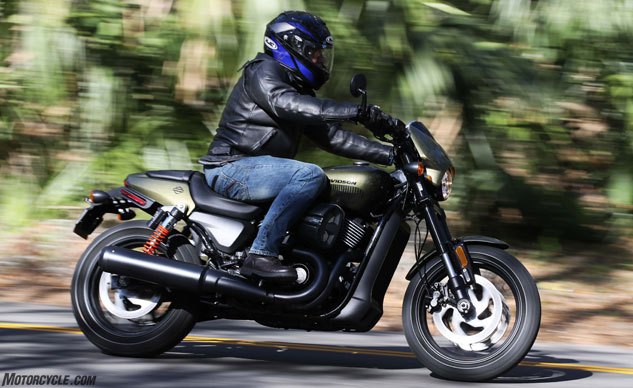

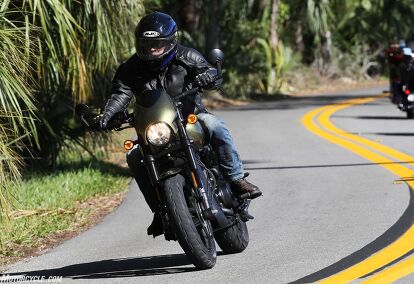


























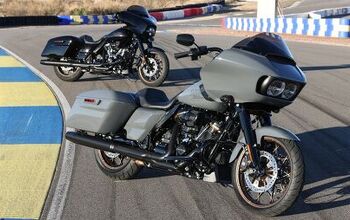
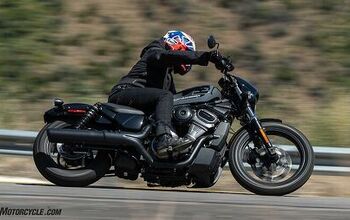
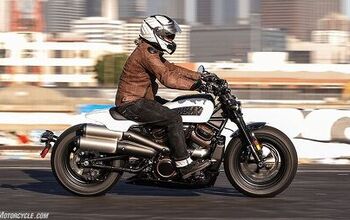












Comments
Join the conversation
I also got cramps in my hips when I rode the Street Rod the other day. Kind of painful. It was fun to ride though. I found it nimble. Looking for something else similar with better ergonomics.
It's a shame that the first Harley I might be tempted to actually buy (not that there haven't been others I've liked, but they were all over priced) seems to have so many drawbacks. Surely Harley's engineers could design a better bike, if only they weren't always required to play JV to the all powerful styling department. Meanwhile, this thing seems like Harley's answer to the Royal Enfield Continental GT.